Zengfeng Huang
Fudan University
EvolProver: Advancing Automated Theorem Proving by Evolving Formalized Problems via Symmetry and Difficulty
Oct 01, 2025Abstract:Large Language Models (LLMs) for formal theorem proving have shown significant promise, yet they often lack generalizability and are fragile to even minor transformations of problem statements. To address this limitation, we introduce a novel data augmentation pipeline designed to enhance model robustness from two perspectives: symmetry and difficulty. From the symmetry perspective, we propose two complementary methods: EvolAST, an Abstract Syntax Tree (AST) based approach that targets syntactic symmetry to generate semantically equivalent problem variants, and EvolDomain, which leverages LLMs to address semantic symmetry by translating theorems across mathematical domains. From the difficulty perspective, we propose EvolDifficulty, which uses carefully designed evolutionary instructions to guide LLMs in generating new theorems with a wider range of difficulty. We then use the evolved data to train EvolProver, a 7B-parameter non-reasoning theorem prover. EvolProver establishes a new state-of-the-art (SOTA) on FormalMATH-Lite with a 53.8% pass@32 rate, surpassing all models of comparable size, including reasoning-based models. It also sets new SOTA records for non-reasoning models on MiniF2F-Test (69.8% pass@32), Ineq-Comp-Seed (52.2% pass@32), and Ineq-Comp-Transformed (34.0% pass@32). Ablation studies further confirm our data augmentation pipeline's effectiveness across multiple benchmarks.
LongLLaDA: Unlocking Long Context Capabilities in Diffusion LLMs
Jun 17, 2025Abstract:Large Language Diffusion Models, or diffusion LLMs, have emerged as a significant focus in NLP research, with substantial effort directed toward understanding their scalability and downstream task performance. However, their long-context capabilities remain unexplored, lacking systematic analysis or methods for context extension. In this work, we present the first systematic investigation comparing the long-context performance of diffusion LLMs and traditional auto-regressive LLMs. We first identify a unique characteristic of diffusion LLMs, unlike auto-regressive LLMs, they maintain remarkably \textbf{\textit{stable perplexity}} during direct context extrapolation. Furthermore, where auto-regressive models fail outright during the Needle-In-A-Haystack task with context exceeding their pretrained length, we discover diffusion LLMs exhibit a distinct \textbf{\textit{local perception}} phenomenon, enabling successful retrieval from recent context segments. We explain both phenomena through the lens of Rotary Position Embedding (RoPE) scaling theory. Building on these observations, we propose LongLLaDA, a training-free method that integrates LLaDA with the NTK-based RoPE extrapolation. Our results validate that established extrapolation scaling laws remain effective for extending the context windows of diffusion LLMs. Furthermore, we identify long-context tasks where diffusion LLMs outperform auto-regressive LLMs and others where they fall short. Consequently, this study establishes the first context extrapolation method for diffusion LLMs while providing essential theoretical insights and empirical benchmarks critical for advancing future research on long-context diffusion LLMs.
Beyond Homogeneous Attention: Memory-Efficient LLMs via Fourier-Approximated KV Cache
Jun 13, 2025Abstract:Large Language Models struggle with memory demands from the growing Key-Value (KV) cache as context lengths increase. Existing compression methods homogenize head dimensions or rely on attention-guided token pruning, often sacrificing accuracy or introducing computational overhead. We propose FourierAttention, a training-free framework that exploits the heterogeneous roles of transformer head dimensions: lower dimensions prioritize local context, while upper ones capture long-range dependencies. By projecting the long-context-insensitive dimensions onto orthogonal Fourier bases, FourierAttention approximates their temporal evolution with fixed-length spectral coefficients. Evaluations on LLaMA models show that FourierAttention achieves the best long-context accuracy on LongBench and Needle-In-A-Haystack (NIAH). Besides, a custom Triton kernel, FlashFourierAttention, is designed to optimize memory via streamlined read-write operations, enabling efficient deployment without performance compromise.
Right Is Not Enough: The Pitfalls of Outcome Supervision in Training LLMs for Math Reasoning
Jun 07, 2025Abstract:Outcome-rewarded Large Language Models (LLMs) have demonstrated remarkable success in mathematical problem-solving. However, this success often masks a critical issue: models frequently achieve correct answers through fundamentally unsound reasoning processes, a phenomenon indicative of reward hacking. We introduce MathOlympiadEval, a new dataset with fine-grained annotations, which reveals a significant gap between LLMs' answer correctness and their low process correctness. Existing automated methods like LLM-as-a-judge struggle to reliably detect these reasoning flaws. To address this, we propose ParaStepVerifier, a novel methodology for meticulous, step-by-step verification of mathematical solutions. ParaStepVerifier identifies incorrect reasoning steps. Empirical results demonstrate that ParaStepVerifier substantially improves the accuracy of identifying flawed solutions compared to baselines, especially for complex, multi-step problems. This offers a more robust path towards evaluating and training LLMs with genuine mathematical reasoning.
Nearly Tight Bounds for Cross-Learning Contextual Bandits with Graphical Feedback
Feb 07, 2025
Abstract:The cross-learning contextual bandit problem with graphical feedback has recently attracted significant attention. In this setting, there is a contextual bandit with a feedback graph over the arms, and pulling an arm reveals the loss for all neighboring arms in the feedback graph across all contexts. Initially proposed by Han et al. (2024), this problem has broad applications in areas such as bidding in first price auctions, and explores a novel frontier in the feedback structure of bandit problems. A key theoretical question is whether an algorithm with $\widetilde{O}(\sqrt{\alpha T})$ regret exists, where $\alpha$ represents the independence number of the feedback graph. This question is particularly interesting because it concerns whether an algorithm can achieve a regret bound entirely independent of the number of contexts and matching the minimax regret of vanilla graphical bandits. Previous work has demonstrated that such an algorithm is impossible for adversarial contexts, but the question remains open for stochastic contexts. In this work, we affirmatively answer this open question by presenting an algorithm that achieves the minimax $\widetilde{O}(\sqrt{\alpha T})$ regret for cross-learning contextual bandits with graphical feedback and stochastic contexts. Notably, although that question is open even for stochastic bandits, we directly solve the strictly stronger adversarial bandit version of the problem.
TGB-Seq Benchmark: Challenging Temporal GNNs with Complex Sequential Dynamics
Feb 05, 2025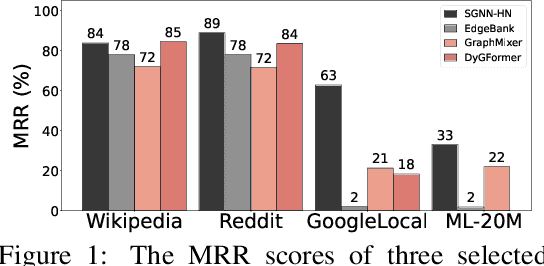
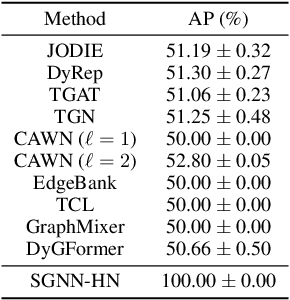


Abstract:Future link prediction is a fundamental challenge in various real-world dynamic systems. To address this, numerous temporal graph neural networks (temporal GNNs) and benchmark datasets have been developed. However, these datasets often feature excessive repeated edges and lack complex sequential dynamics, a key characteristic inherent in many real-world applications such as recommender systems and ``Who-To-Follow'' on social networks. This oversight has led existing methods to inadvertently downplay the importance of learning sequential dynamics, focusing primarily on predicting repeated edges. In this study, we demonstrate that existing methods, such as GraphMixer and DyGFormer, are inherently incapable of learning simple sequential dynamics, such as ``a user who has followed OpenAI and Anthropic is more likely to follow AI at Meta next.'' Motivated by this issue, we introduce the Temporal Graph Benchmark with Sequential Dynamics (TGB-Seq), a new benchmark carefully curated to minimize repeated edges, challenging models to learn sequential dynamics and generalize to unseen edges. TGB-Seq comprises large real-world datasets spanning diverse domains, including e-commerce interactions, movie ratings, business reviews, social networks, citation networks and web link networks. Benchmarking experiments reveal that current methods usually suffer significant performance degradation and incur substantial training costs on TGB-Seq, posing new challenges and opportunities for future research. TGB-Seq datasets, leaderboards, and example codes are available at https://tgb-seq.github.io/.
High Probability Bound for Cross-Learning Contextual Bandits with Unknown Context Distributions
Oct 05, 2024Abstract:Motivated by applications in online bidding and sleeping bandits, we examine the problem of contextual bandits with cross learning, where the learner observes the loss associated with the action across all possible contexts, not just the current round's context. Our focus is on a setting where losses are chosen adversarially, and contexts are sampled i.i.d. from a specific distribution. This problem was first studied by Balseiro et al. (2019), who proposed an algorithm that achieves near-optimal regret under the assumption that the context distribution is known in advance. However, this assumption is often unrealistic. To address this issue, Schneider and Zimmert (2023) recently proposed a new algorithm that achieves nearly optimal expected regret. It is well-known that expected regret can be significantly weaker than high-probability bounds. In this paper, we present a novel, in-depth analysis of their algorithm and demonstrate that it actually achieves near-optimal regret with high probability. There are steps in the original analysis by Schneider and Zimmert (2023) that lead only to an expected bound by nature. In our analysis, we introduce several new insights. Specifically, we make extensive use of the weak dependency structure between different epochs, which was overlooked in previous analyses. Additionally, standard martingale inequalities are not directly applicable, so we refine martingale inequalities to complete our analysis.
Your Graph Recommender is Provably a Single-view Graph Contrastive Learning
Jul 25, 2024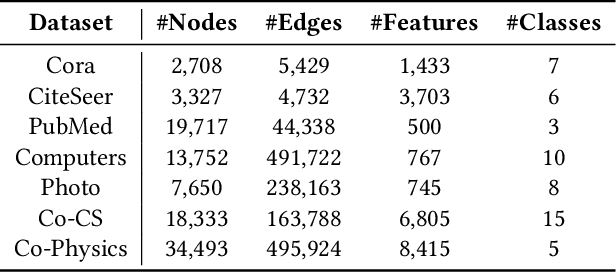


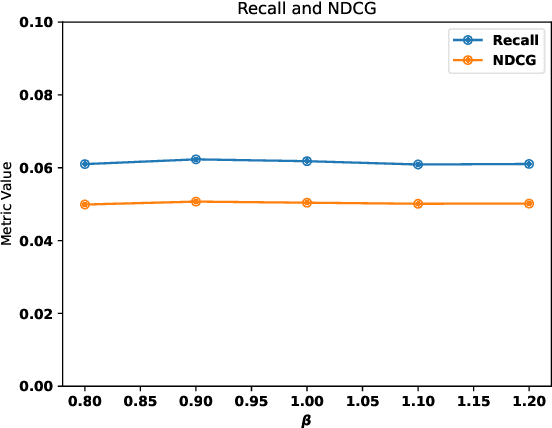
Abstract:Graph recommender (GR) is a type of graph neural network (GNNs) encoder that is customized for extracting information from the user-item interaction graph. Due to its strong performance on the recommendation task, GR has gained significant attention recently. Graph contrastive learning (GCL) is also a popular research direction that aims to learn, often unsupervised, GNNs with certain contrastive objectives. As a general graph representation learning method, GCLs have been widely adopted with the supervised recommendation loss for joint training of GRs. Despite the intersection of GR and GCL research, theoretical understanding of the relationship between the two fields is surprisingly sparse. This vacancy inevitably leads to inefficient scientific research. In this paper, we aim to bridge the gap between the field of GR and GCL from the perspective of encoders and loss functions. With mild assumptions, we theoretically show an astonishing fact that graph recommender is equivalent to a commonly-used single-view graph contrastive model. Specifically, we find that (1) the classic encoder in GR is essentially a linear graph convolutional network with one-hot inputs, and (2) the loss function in GR is well bounded by a single-view GCL loss with certain hyperparameters. The first observation enables us to explain crucial designs of GR models, e.g., the removal of self-loop and nonlinearity. And the second finding can easily prompt many cross-field research directions. We empirically show a remarkable result that the recommendation loss and the GCL loss can be used interchangeably. The fact that we can train GR models solely with the GCL loss is particularly insightful, since before this work, GCLs were typically viewed as unsupervised methods that need fine-tuning. We also discuss some potential future works inspired by our theory.
HAF-RM: A Hybrid Alignment Framework for Reward Model Training
Jul 04, 2024Abstract:The reward model has become increasingly important in alignment, assessment, and data construction for large language models (LLMs). Most existing researchers focus on enhancing reward models through data improvements, following the conventional training framework for reward models that directly optimizes the predicted rewards. In this paper, we propose a hybrid alignment framework HaF-RM for reward model training by introducing an additional constraint on token-level policy probabilities in addition to the reward score. It can simultaneously supervise the internal preference model at the token level and optimize the mapping layer of the reward model at the sequence level. Theoretical justifications and experiment results on five datasets show the validity and effectiveness of our proposed hybrid framework for training a high-quality reward model. By decoupling the reward modeling procedure and incorporating hybrid supervision, our HaF-RM framework offers a principled and effective approach to enhancing the performance and alignment of reward models, a critical component in the responsible development of powerful language models. We release our code at https://haf-rm.github.io.
Optimal Matrix Sketching over Sliding Windows
May 13, 2024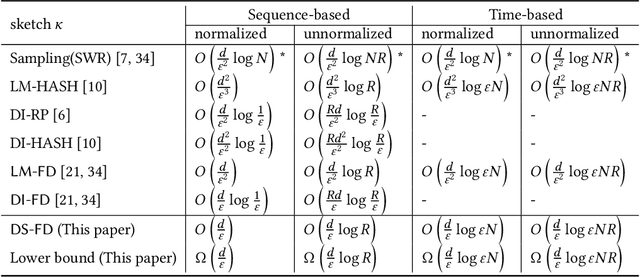
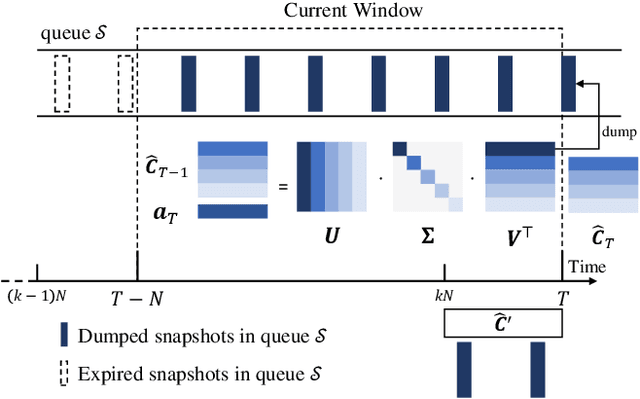
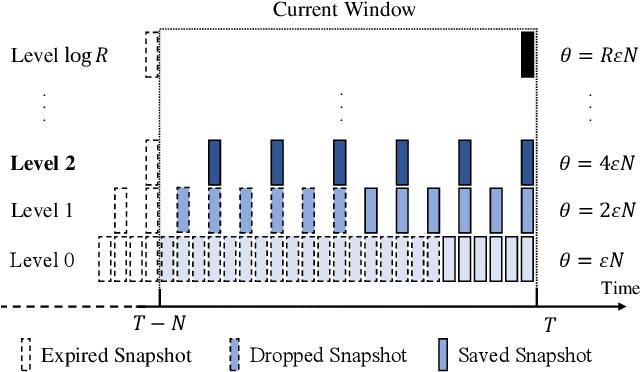

Abstract:Matrix sketching, aimed at approximating a matrix $\boldsymbol{A} \in \mathbb{R}^{N\times d}$ consisting of vector streams of length $N$ with a smaller sketching matrix $\boldsymbol{B} \in \mathbb{R}^{\ell\times d}, \ell \ll N$, has garnered increasing attention in fields such as large-scale data analytics and machine learning. A well-known deterministic matrix sketching method is the Frequent Directions algorithm, which achieves the optimal $O\left(\frac{d}{\varepsilon}\right)$ space bound and provides a covariance error guarantee of $\varepsilon = \lVert \boldsymbol{A}^\top \boldsymbol{A} - \boldsymbol{B}^\top \boldsymbol{B} \rVert_2/\lVert \boldsymbol{A} \rVert_F^2$. The matrix sketching problem becomes particularly interesting in the context of sliding windows, where the goal is to approximate the matrix $\boldsymbol{A}_W$, formed by input vectors over the most recent $N$ time units. However, despite recent efforts, whether achieving the optimal $O\left(\frac{d}{\varepsilon}\right)$ space bound on sliding windows is possible has remained an open question. In this paper, we introduce the DS-FD algorithm, which achieves the optimal $O\left(\frac{d}{\varepsilon}\right)$ space bound for matrix sketching over row-normalized, sequence-based sliding windows. We also present matching upper and lower space bounds for time-based and unnormalized sliding windows, demonstrating the generality and optimality of \dsfd across various sliding window models. This conclusively answers the open question regarding the optimal space bound for matrix sketching over sliding windows. Furthermore, we conduct extensive experiments with both synthetic and real-world datasets, validating our theoretical claims and thus confirming the correctness and effectiveness of our algorithm, both theoretically and empirically.
 Add to Chrome
Add to Chrome Add to Firefox
Add to Firefox Add to Edge
Add to Edge